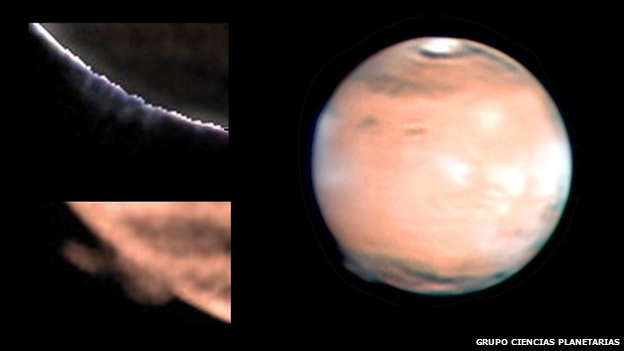
Los Angeles
Scientists are wrestling with the identity of strange, giant plumes that mysteriously appeared and later vanished high above the surface of Mars. Such plumes, described in the journal Nature, defy scientists’ expectations of how the Red Planet’s atmosphere works.
In two separate events, a strange plume was spotted more than 250km above the surface of the planet, once in March and next in April 2012. This is highly unusual — while there are clouds on Mars, the highest they go is usually around 100km, said study co-author Antonio Garcia Munoz, a planetary scientist with the European Space Agency’s European Space Research and Technology Centre in the Netherlands. On top of that, the plumes were incredibly broad, stretching across an area measuring roughly 1,000km by 500km.
“It’s quite shocking that this is happening at a 200-kilometer altitude,” Garcia Munoz said. “This is completely unusual.”
Some 20 amateur astronomers saw and documented the strange structures, each of which lasted about 10 days. The images they took were invaluable to scientists, given that none of the satellites around Mars was in the right place at the right time to be able to capture the strange formation.
The plumes were spotted on the “limb” of the planet _ the edge where you can see the atmosphere as if it were the thin rind around an orange sliced in half. The scientists found that each day, the plume was visible at the morning’s day-night boundary, but not the evening transition. It seemed that these plumes were shrinking during the daytime and regrowing overnight, giving them a cyclic, possibly cloudlike property.
Had something like this ever happened before? The scientists also looked back at old data and also discovered images taken by NASA’s Hubble Space Telescope in May 1997 that revealed a similarly strange, high plume.
The researchers have two main explanations. The haze could be caused by a cloud of carbon dioxide ice or water ice particles. But it could also be caused by an aurora, rather like the one responsible for the northern lights on Earth.
But neither of these possibilities quite fit the data, Garcia Munoz said.
“Both tentative explanations have pros and cons,” he added, “and the final conclusion is that we are not so sure what is causing this plume.”
If it does turn out to be a cloud, the finding could cause planetary scientists to re-evaluate certain theories of how the upper atmosphere works. For example, if this plume is made of ice particles, this would mean that the atmosphere would have to experience a roughly 50-degree-Celsius drop from day to night _ which is far more extreme than expected for the upper atmosphere.
For now, Garcia Munoz said, they’ve done what they can with the data; scientists will have to hope another plume comes, and that they can train one of the many Martian orbiters’ cameras on the odd structure. But it’s unclear when, or if, that will happen anytime soon.
“I don’t know what to expect, to be honest,” Garcia Munoz said.












